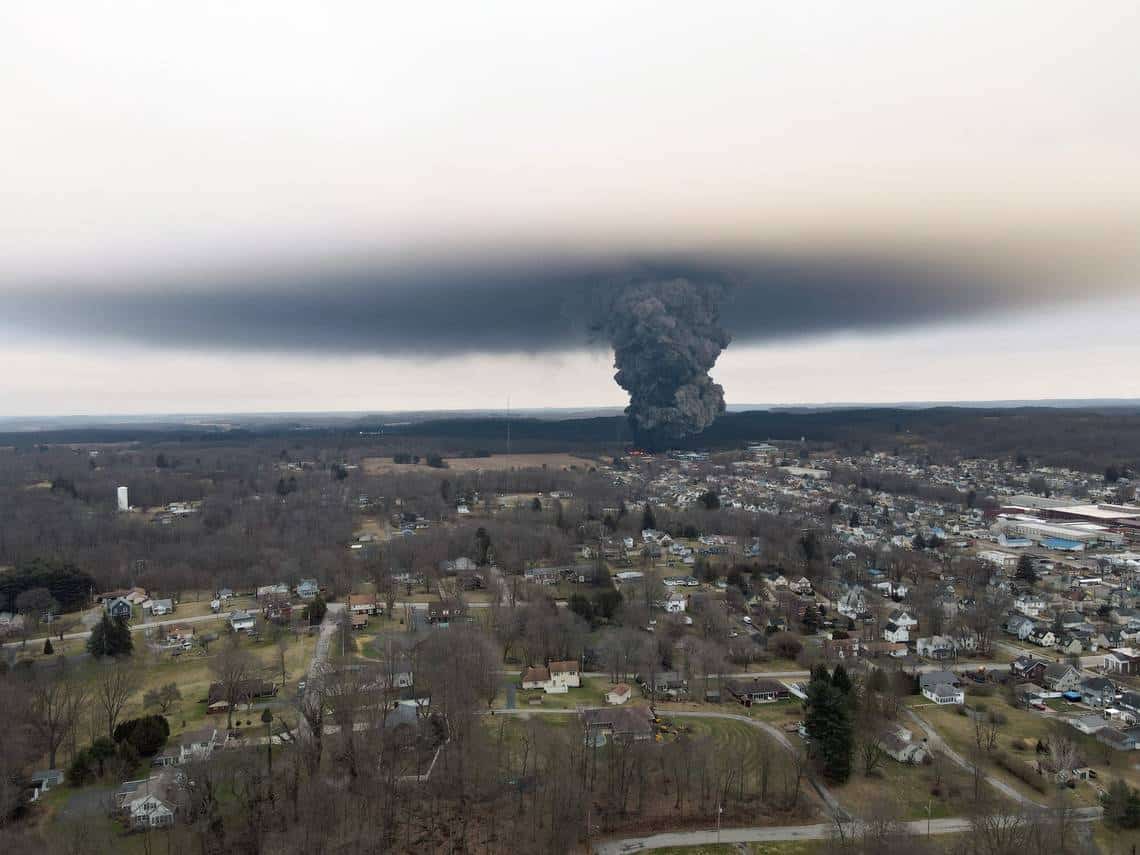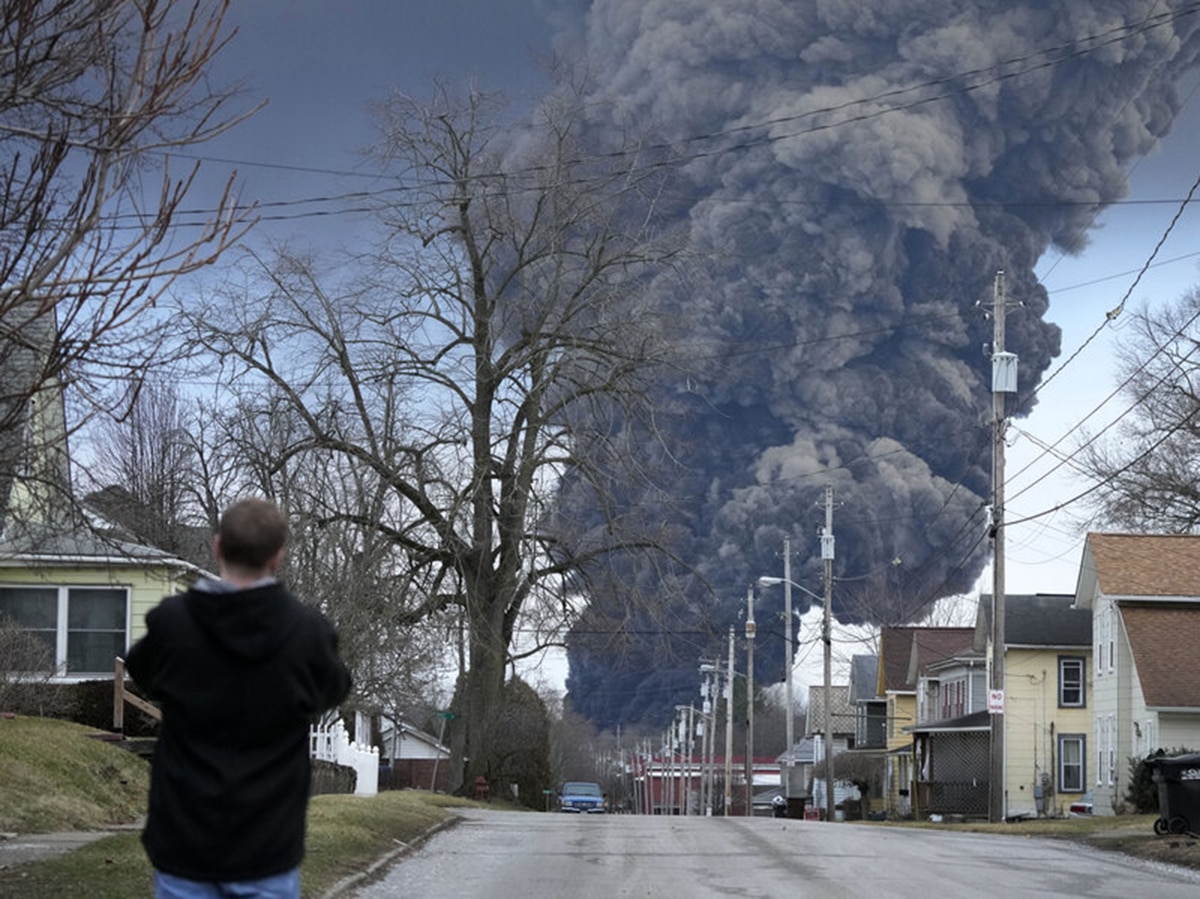
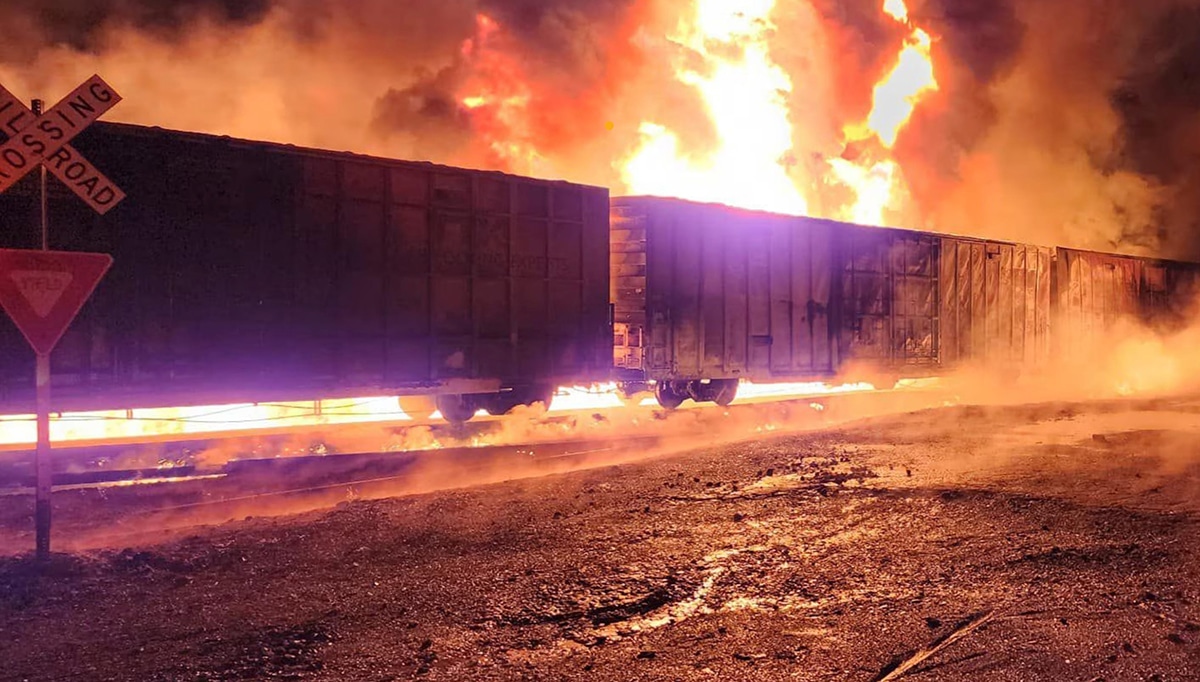
Palestine, Ohio train wreck: It’s the dioxin
by | Feb 13, 2023
Most coverage of the train wreck in Palestine, Ohio is missing one word: dioxin. There were reportedly 14 tanker cars full of vinyl chloride, a precursor to polyvinyl chloride — that is, vinyl. Burning vinyl is the most serious source of dioxin in the environment — whether from trash incinerators, house fires or chemical spills.
This mess of 14 tanker cars (really, many more, but 14 had vinyl chloride) was then set on fire by the government, apparently to make it easier to clear the railroad tracks. This was the worst possible decision. It has turned many, many miles into no-man’s land.
Note that dioxin goes by several other names, including TCDD and is sometimes abbreviated 2,3,7,8.
This is not a local issue. This massive plume will spread far and wide, and is being blown by the prevailing winds across Ohio, Pennsylvania and New York State, toward the population centers of the northeastern U.S.
Dioxin has been out of the news for more than 30 years. After a series of fraudulent articles in The New York Times that claimed they are as dangerous as sunbathing, the issue disappeared. A federal reassessment of dioxin’s toxicity was stuffed early in the Clinton administration. I cover the reassessment in this 1994 article I wrote for Sierra.
Dioxins are Degradation Byproducts of Chlorine-Based Chemicals
Dioxins and their first cousins furans are compounds created when chlorinated chemicals burn, explode or degrade. They are never made as a product; they are a contaminant and degradation product. They are directly related to PCBs, which are considered dioxin-like compounds.
Dioxins were the extremely toxic component in the Vietnam War-era defoliant Agent Orange. The were at the Love Canal in Niagara Falls; they were the toxin involved in the evacuation and dissolution of Times Beach, Missouri. They are the cause of toxic shock syndrome from bleached paper tampons.
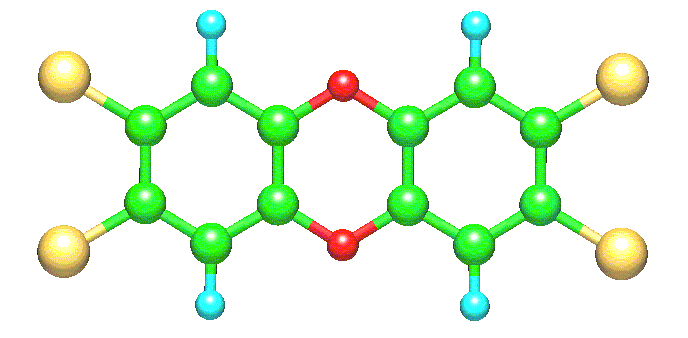
2,3,7,8-TCDD, or dioxin for short. Note the double benzene ring structure, which makes them extremely durable and persistent. The shape — a planar or flat molecule — is largely responsible for its toxicity.
Dioxins are acute toxins on one level. There will be a lot of dead fish and animals in the path of the Ohio plume — and people will get very sick immediately. Kids are extremely sensitive due to their low body weight.
Dioxins are a Hormonal Toxin
But then there is another level of the problem. Dioxins are 1) hormonally toxic and 2) they are extremely persistent and they then build up in the food chain, generally in lipids. They are bioactive. All this BS projected onto viruses is absolutely true for dioxins, though the contagion factor is different (running through families for instance, passed through mother’s milk, affecting whole communities through a toxic release, etc.).
Dioxins are connected to every other toxins issue that ever lived, from DDT to PCBs to Roundup…they are orders of magnitude above in their effects, though it’s worth reading this for some background.
Many PCBs are close enough to dioxins to qualify as such; and PCBs degrade into dibenzofurans (also called furans), which are dioxins with one molecule of oxygen instead of two. Dioxins are never made intentionally; similar toxins are, but dioxin per se is a byproduct of other chemical processes, or a degradation byproduct.
The plastics industry is now the number one dioxin polluter (thanks to polyvinyl chloride), followed by the pulp and paper industry, due to the bleach used to make paper and absorbent paper products white. This is why nobody should ever use low-grade, non-organic paper feminine products. Use something that is not bleached with chlorine.
Please see my coverage of the most famous dioxin lawsuit, Kemner v. Monsanto, about another train wreck, in Sturgeon, Missouri. In this lawsuit, the ugly truth about dioxin and Monsanto came out into the open.
One Quote is Making it Into Some Articles
There is one accurate quote about dioxin that is making the rounds, in connection to the Palestine disaster:
Neil Donahue, a professor chemistry at Carnegie Mellon University in nearby Pittsburgh, said he worries that the burning could have formed dioxins, which are created from burning chlorinated carbon materials.
“Vinyl chloride is bad, dioxins are worse as carcinogens and that comes from burning,” Donahue said.
Dioxins are a group of persistent environmental pollutants that last in the ground and body for years and have been one of the major environmental problems and controversies in the United States.
Dr. Lynn Goldman, dean of George Washington University’s School of Public Health, agrees this is a possible risk, but is more concerned about uncombusted vinyl chloride vapors that could be lurking in the immediate vicinity.
“Until there has been a thorough assessment, the soot as well as any other materials should in my opinion be treated as contaminated by vinyl chloride and/or dioxins or other contaminants until proven otherwise,” she said.
As Peter Montague writes in the historical articles below:
How can we express this in terms that people can grasp? Let’s compare it to one single aspirin tablet. One aspirin tablet weighs 5 grains (or 325 milligrams, or 325 trillion femtograms), so to express one “safe” lifetime dose of 2,3,7,8-TCDD, you would take a single aspirin tablet and divide it into 32 million (actually 32,172,218) miniscule pieces. Then one of those tiny pieces would represent one “safe” lifetime dose of 2,3,7,8-TCDD.
We will have more on Friday’s edition of Planet Waves FM.

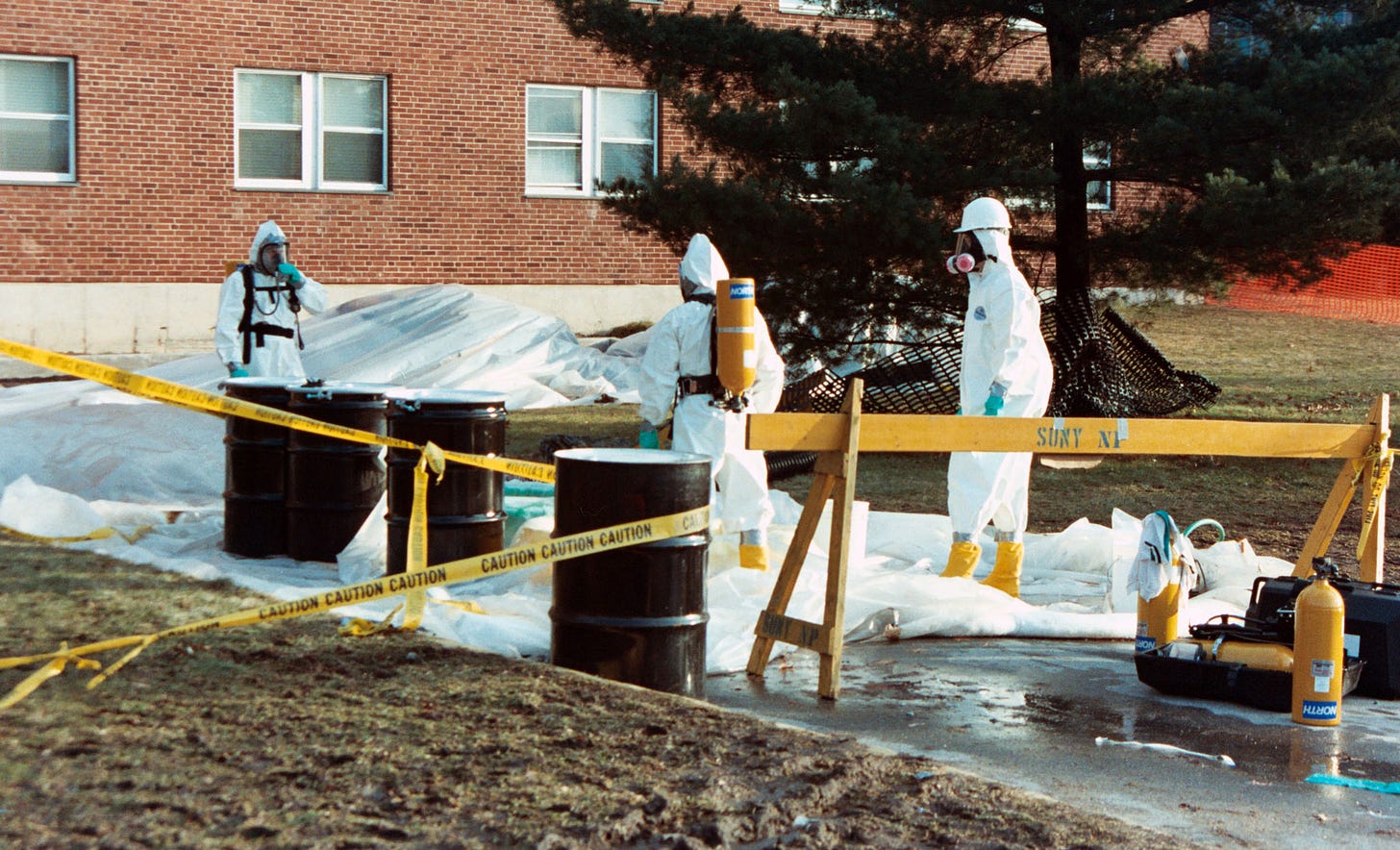
Even this level of protection is not truly safe for the workers, who are cleaning a dioxin-contaminated area outside Bliss Residence Hall at SUNY New Paltz, January 1992. Photo by Eric Coppolino for Student Leader News Service.
Brief Summary of Dioxin Incidents and Fraud
By Peter Montague, Ph.D. | Link to Original in Rachel’s Hazardous Waste News from March 1991. Peter was sued for libel by Monsanto for these articles. See my coverage.
FOR YEARS, INDUSTRY SCIENTISTS have been claiming there’s no evidence that dioxins cause cancer in humans. Now there is mounting evidence that such claims rely heavily on studies that are fraudulent. Two companies recently accused of producing fraudulent dioxin-and-health data are Monsanto and BASF.
Monsanto
A scientist with U.S. Environmental Protection Agency (EPA) says Monsanto falsified data in important studies that Monsanto used to support its claim that dioxin does not cause cancer in humans. Dr. Cate Jenkins, a chemist in EPA’s Office of Solid Waste and Emergency Response, says EPA itself relied upon Monsanto’s fraudulent data in setting health standards for dioxin, and Jenkins has asked the EPA’s Science Advisory Board to reopen the matter of EPA’s dioxin standards, to take a fresh look at available data.1
Two important sources of dioxins in the environment are old chemical dumps and the incineration of municipal solid wastes,2 which is why EPA is concerned about allowable levels of human exposures to dioxin.
BASF
The British technical journal, NEW SCIENTIST, says, “A new analysis by a West German epidemiologist may have established the first clearcut evidence of a direct link between exposure to dioxins and cancer in humans. Friedemann Rohleder, an independent specialist, has produced a report detailing an unexpectedly high incidence of cancer among workers exposed to dioxins during an industrial accident at a chemicals plant in 1953.3
“The plant, operated by the West German company BASF, made trichlorophenol. Rohleder claims the company presented the data in a way that disguised the cancers,” says NEW SCIENTIST.
Background
Each of these claims of fraud relates to an industrial accident in which workers were exposed to dioxins; follow-up medical studies funded by the responsible companies have been published in mainstream scientific journals, claiming to show that no excess cancers have occurred in the dioxin-exposed workers. In fact, excess cancers have occurred, but it appears that the data have been manipulated to hide the facts.
The Monsanto Case
In 1949, an explosion occurred at a Monsanto chemical factory in Nitro, West Virginia; as a result, many workers in the plant were exposed to the herbicide 2,4,5-T, which was contaminated with dioxin. (This herbicide was later the principal component of Agent Orange, the chemical defoliant used by the U.S. in Viet Nam.) In subsequent years, two Monsanto scientists, J.A. Zack and R. W. Gaffey, studied the exposed workers, comparing their health against the health of a similar group of workers who were not exposed to dioxin or 2,4,5-T.4
According to court documents attached to the EPA memo,”Zack and Gaffey deliberately and knowingly omitted 5 deaths from the exposed group and took four workers who had been exposed and put these workers in the unexposed group, serving, of course, to decrease the death rate in the exposed group and increase the death rate in the unexposed group.”
Other studies of this same accident were also fraudulent, according to the same court documents, including a study by R.R. Suskind published in the Journal of the American Medical Association [5] “This published study of the workers exposed in the 1949 accident reported only 14 cancers in the exposed group and 6 in the unexposed group” (a smaller cohort).
However, the medical records produced [by Monsanto] to the Plaintiffs conclusively prove gross miscalculations and omissions… there were 28 cancers in the group that had been exposed to dioxins in 1949 as opposed to only 2 cancers in the unexposed group.” Mr. Suskind published two other reports 6,7 on the same accident, using his same data, to reach the conclusion that dioxin does not cause cancer.
The BASF Case
On the night of November 17, 1953, a runaway chemical reaction spewed dioxin-contaminated chemicals over workers and community residents of two small German cities, Mannheim and Ludwigshafen. Subsequently, an epidemiological study was used to deny workers any compensation for ailments they claimed they suffered as a result of exposure.
In keeping with German law, the workers retained their own expert to review the data. Their expert, Friedemann Rohleder, received the data from the German government but found, to his surprise, that all the data actually came from the BASF company itself. He analyzed the data and found that some workers suffering from chloracne, which is universally acknowledged to be evidence of high exposure to dioxin, had been placed in the low-exposure or non-exposed group.
He found evidence of “diluting” the exposed group with 20 plant supervisory staff who, Rohleder believes, were not exposed. When Rohleder omitted the 20 supervisory staff, his analysis revealed statistically significant increases in two groups of cancers: cancers of the respiratory organs (lungs, trachea, etc.), and cancers of the digestive tract. “This analysis adds further evidence to an association between dioxin exposure and human malignancy,” Rohleder told New Scientist.
Part Two: Gauging the Toxicity of Dioxin
[Link to Original | Continuing our series on dioxin. Page numbers in parentheses refer to the ATSDR (the federal Agency for Toxic Substances and Disease Registry) Toxicological Profile for dioxin, cited in our last paragraph, below.]
It has become fashionable to pooh-pooh dioxin. We believe there are two reasons why this is occurring. First, some scientists have been publishing studies indicating that humans exposed to dioxin do not have an increased risk of cancer. As we saw in RHWN #171, some of the most important of these studies have now been exposed as fraudulent. The second reason is that dioxin is so toxic that it is difficult to express its potency in normal terms; therefore the media frequently print scary claims without offering much evidence, leading some people to conclude (incorrectly) that there isn’t much substance to any claims about the extreme toxicity of dioxin.
In this series, we hope to lay the groundwork for an understanding of dioxin, to help people put dioxin into perspective. Some of what follows may seem a bit more technical than you are accustomed to reading in this newsletter; but stick with it, and you’ll see why we have taken this approach.
The scientific and medical evidence presented by ATSDR forces us to conclude that dioxin deserves our greatest respect. It seems to be one of the two or three most toxic chemicals ever discovered, and it is produced as a byproduct of several different industrial processes. For years, industry has been dumping dioxin into the environment in large quantities without paying attention to the consequences. This does not mean there have been no consequences; it just means no one has made any systematic effort to tally them up.
Dioxin is a family of chemicals (75 in all) that does not occur naturally, nor is it intentionally manufactured by any industry (pg. 1). The most toxic dioxin is called 2,3,7,8-TCDD. Dioxins are produced as byproducts of the manufacture of some herbicides (for example, 2,4,5-T), wood preservatives made from trichlorophenols, and some germicides (for example, hexachlorophene). Dioxins are also produced by the manufacture of pulp and paper, by the combustion of wood in the presence of chlorine, by fires involving chlorinated benzenes and biphenyls (e.g., PCBs), by the exhaust of automobiles burning leaded fuel, and by municipal solid waste incinerators.
ATSDR says, “2,3,7,8-TCDD is highly toxic to all laboratory animals tested….” (pg. 11). Even the most conservative of toxicologists says, “TCDD has been called the most toxic synthetic chemical known to man. If its acute toxicity to the guinea pig, and even the rat and mouse, is the criterion, the statement is probably correct…. TCDD is unquestionably a chemical of supreme toxicity to experimental animals. Moreover, severe chronic effects from low dosages have also been demonstrated in experimental animals. Therefore, the concern about its effects on human health and the environment is understandable.”1
In cases of high exposure of humans through industrial accidents, 2,3,7,8-TCDD causes a severe acne (called chloracne) which is not just a skin ailment; chloracne is a systemic disease that is more disfiguring than teenage acne and its effects last for years (in some cases, decades) after exposure (pgs. 3, 39).
There is “suggestive evidence” that 2,3,7,8-TCDD causes liver damage in humans (pgs. 3, 52-53). It definitely causes severe liver damage in animals.
In animals, 2,3,7,8-TCDD is toxic to the immune system; such effects have not been proven in humans (pgs. 3, 40, 54-56). In animals, 2,3,7,8-TCDD causes reproductive disorders, including spontaneous abortions. Monkeys are particuarly sensitive to reproductive effects from exposure to 2,3,7,8-TCDD. Such effects have not been proven in humans (pgs. 3, 17, 58-59). In animals, dioxin causes genetic damage (pgs. 60-61).
Both the U.S. Environmental Protection Agency (EPA) and the International Agency for Research on Cancer (IARC) have concluded that dioxin is a “probable human carcinogen” (pgs. 7, 61-68, 94). As we saw in RHWN #171, scientists within EPA have asked that this question be reviewed again because some of the key studies of dioxin and cancer were fraudulent, and EPA has relied on these fraudulent studies to set current standards.
How can we judge the toxicity of dioxin (or of any chemical, for that matter)? One way is to look at the standards that have been set by regulatory agencies.
In the case of dioxin, EPA has calculated a “safe” dose, taking into consideration dioxin’s ability to cause cancer. The “safe” dose is expressed in extremely small units: femtograms. There are 28 grams in an ounce, and one femtogram is 0.000,000,000,000,001 grams, or one quadrillionth of a gram, or 10**-15 (or, 10 raised to the power of negative 15) grams.
EPA believes that ingesting (eating) 6.4 femtograms (6.4 x 10**-15 grams) of 2,3,7,8-TCDD per kilogram of body weight per day would cause cancer in one in a million people so exposed (pg. 95). Since an average adult weighs 62 kilograms or 137 pounds (average men weigh 70 kilograms [154 pounds] and average women weigh 55 kg [120 pounds]), the EPA is saying that 397 femtograms of 2,3,7,8-TCDD consumed in food each day would kill one-in-a-million humans so exposed. Over a year’s time, 397 femtograms per day add up to 145,000 femtograms; over a 70-year lifetime, this would add up to 10.1 million femtograms, so 10.1 million femtograms (or 0.01 micrograms) is the maximum amount you could safely get into your body during your entire lifetime, EPA believes.
How can we express this in terms that people can grasp?
Let’s compare it to one single aspirin tablet. One aspirin tablet weighs 5 grains (or 325 milligrams, or 325 trillion femtograms), so to express one “safe” lifetime dose of 2,3,7,8-TCDD, you would take a single aspirin tablet and divide it into 32 million (actually 32,172,218) miniscule pieces. Then one of those tiny pieces would represent one “safe” lifetime dose of 2,3,7,8-TCDD.
Another comparison: A single grain of table salt weighs approximately 0.1 milligrams or 100 billion femtograms, so to get an amount of table salt that weighs the same amount as one “safe” lifetime dose of 2,3,7,8-TCDD, you would divide a single grain of table salt into 9,900 microscopic pieces. One of those tiny pieces would represent a “safe” lifetime dose of dioxin.
The U.S. Food and Drug Administration (FDA) has its own way of calculating the same one-in-a-million cancer risk and they believe the EPA has overestimated the hazard by a factor of 10. In other words, FDA believes you could represent a “safe” dose of 2,3,7,8-TCDD by dividing a single grain of table salt into 990 pieces, with one of those pieces representing a safe lifetime dose. The federal Centers for Disease Control (CDC) in Atlanta has done its own calculation, concluding that the cancer hazard from dioxin is about half-way between the EPA’s estimate and the FDA’s estimate. EPA says 6.4 femtograms per kilogram of body weight per day is the safe dose; CDC says the correct number is 27.6; FDA says it’s 57.2 (pg. 95). No matter which agency does the calculation, there’s no escaping the fact that dioxin is considered supremely toxic.
One other way to understand the toxicity of dioxin is to compare the dioxin “reference dose” established by EPA to the “reference dose” they have set for other common toxic materials. The “reference dose” is the highest amount they believe you could eat regularly without incurring any disease (not considering cancer).
The reference dose for dioxin is 0.000,000,001 milligrams per kilogram of body weight per day (mg/kg/day) (pg. 94); the reference dose for the toxic metal cadmium2 is 0.001 mg/kg/day and the “reference dose” for the toxic metal arsenic3 is the same as for cadmium.2 Thus we can see that EPA considers dioxin in food 1,000,000 times (one million times) more toxic than cadmium or arsenic3, not counting the cancer hazard from dioxin. Yes, dioxin is toxic, no doubt about it.


